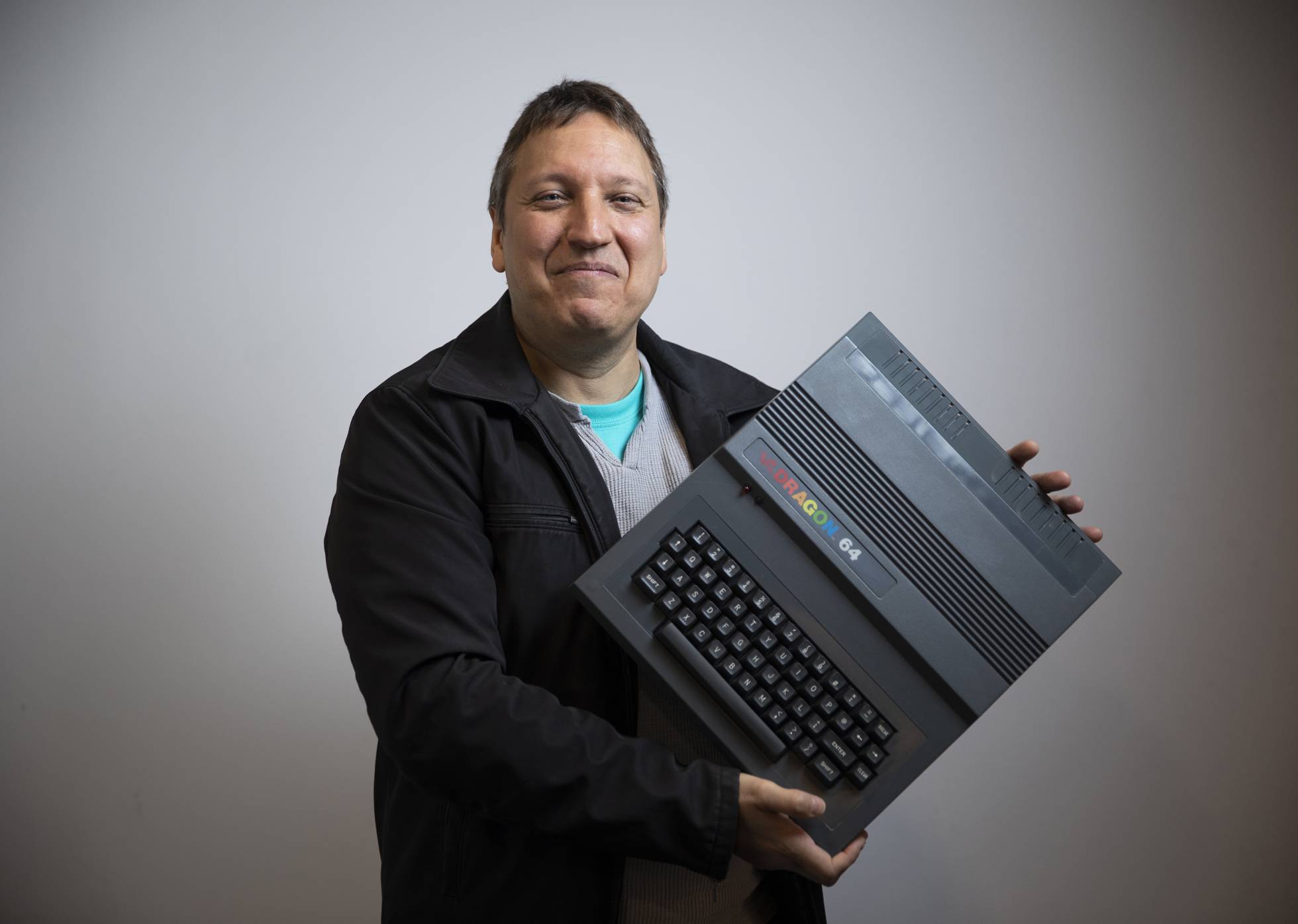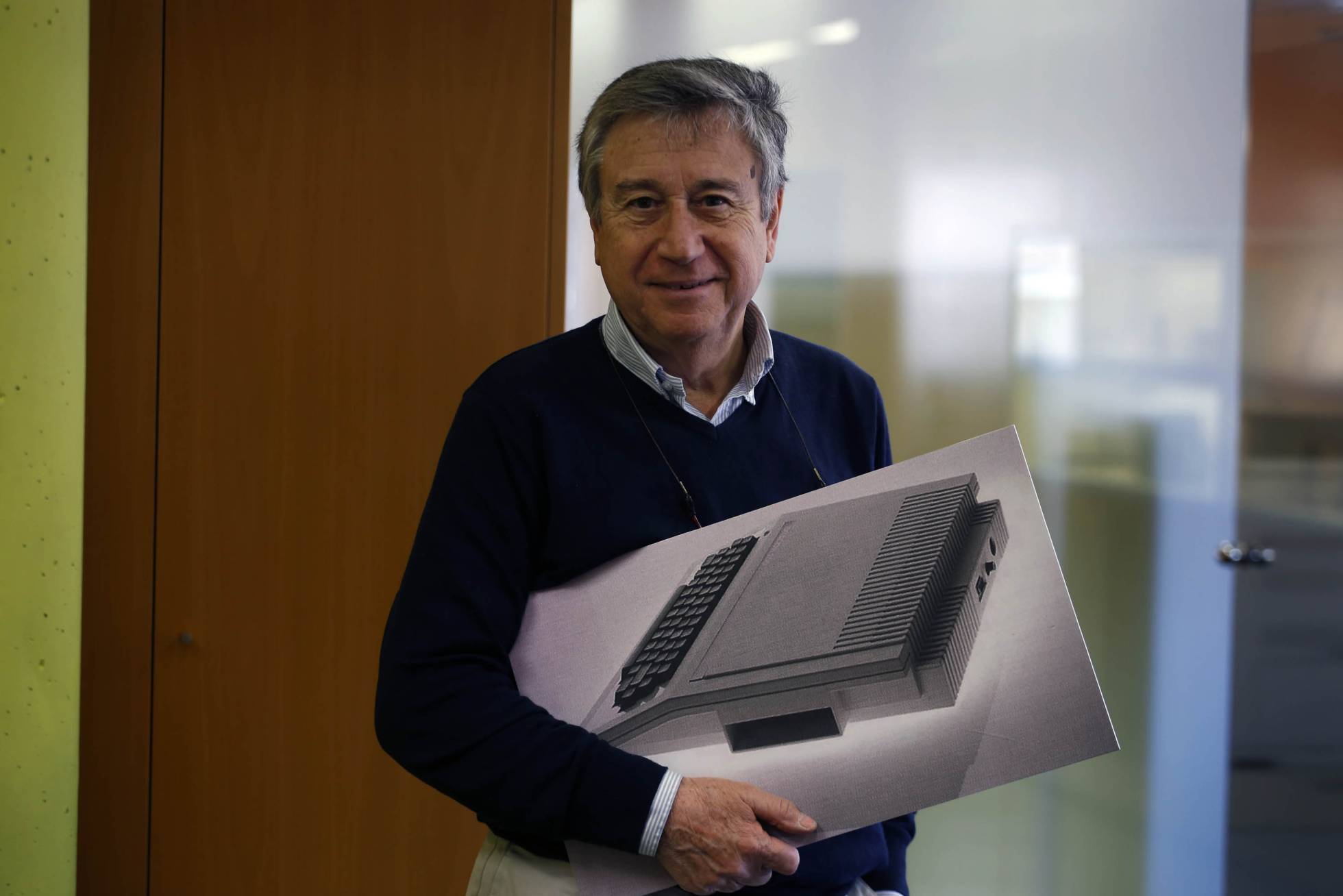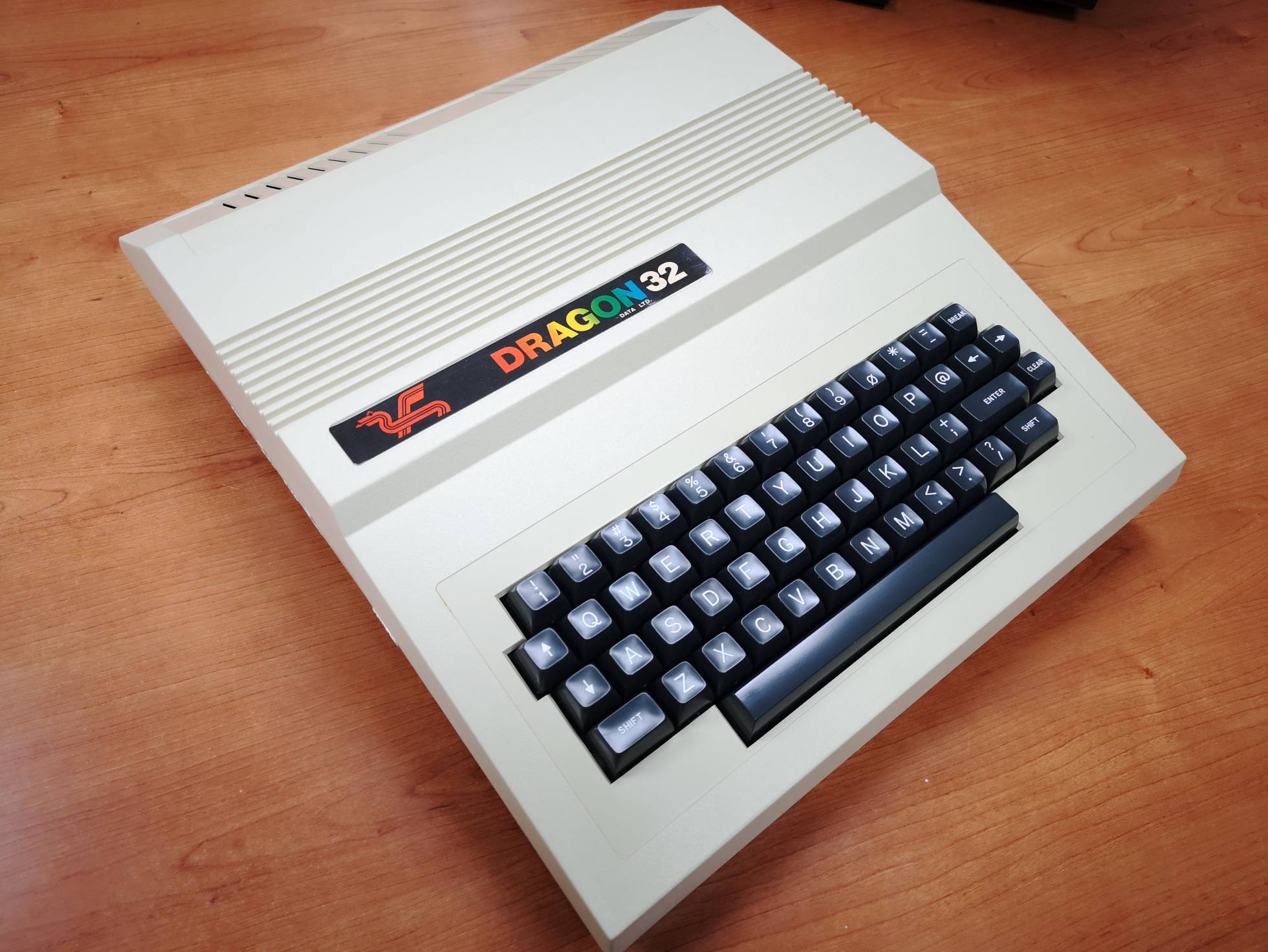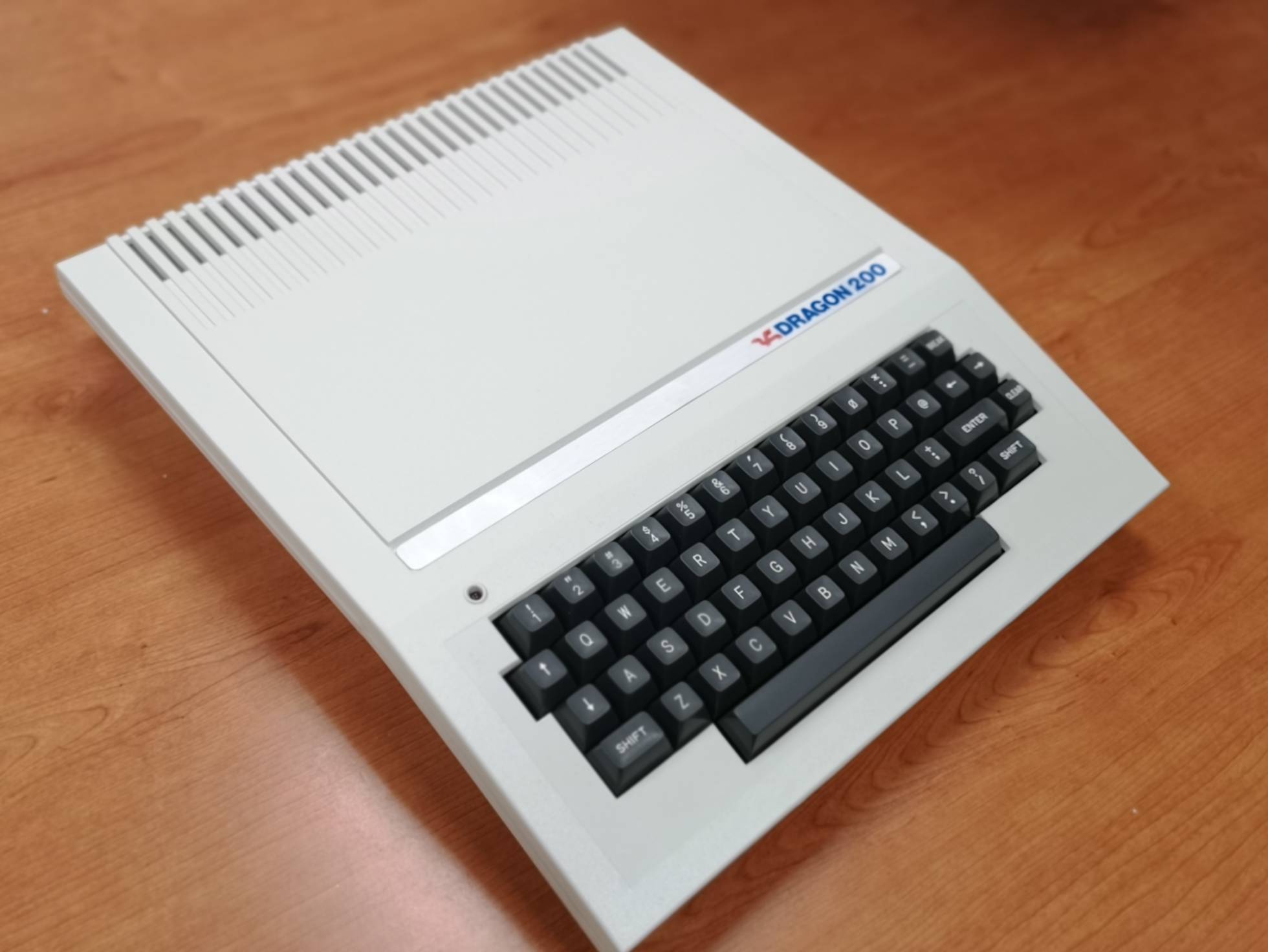| Jordi Palet : Director of R&D of Eurohard |
|
Taken from a Spanish article in December 2019, which can be found here. Please see below for the archived and (google) translated version. |
|
When Extremadura wanted to
be the Spanish Silicon Valley
The
production in a plant of Casar de Cáceres of the Dragon computers, which
had their program on TV3, is one of the most fascinating technological
phenomena of the eighties |
 |
| Jordi Palet, director of R&D of Eurohard when he was barely 18 years old, holds an original Dragon 64 from his private collectionn |
| On December 19, 1984, the president of Extremadura , Juan Carlos Rodríguez Ibarra, inaugurated the Dragon computer plant in Casar de Cáceres . The factory had been a feed store. "I thought it was a very cute factory, surrounded by fields," recalls Javier Saavedra, CEO. |
| One of the attendees remembers that Ibarra mentioned Silicon Valley as a model. The president himself does not deny it today: "It was surprising for most of Extremadura, but it was an opportunity for me. I had been president of a community for a year that had never been in a technological or industrial revolution. They wanted us to grow tomatoes and potatoes, but I wanted another way, "he says. |
| If the idea that the poorest region of Spain was a technological center in 1984 seems difficult today, it seemed so too. When Alfonso González, purchasing director, wanted to call the factory from abroad, he had to ask for the conference hours in advance. A British engineer remembers how the bus passed over the factory's main power cable: "Since I saw it, I asked to get off before and see how the bus jumped on the cable without me riding," according to Lydon Davies. |
| "Everyone thought it was a camel, a story, a scam," Ibarra recalls. But there was a group of men - they were all men - who wanted to try. It probably helped that most of the investment was public money. Some will call it a pitch, others will say it was a missed opportunity. |
| These computers from Extremadura have been the object of nostalgia and endless legends in the community passionate about the beginnings of computer science in Spain. EL PAÍS for the first time has contacted the protagonists who are alive to reconstruct their history. |
| Dragon Data was a Welsh company that sold 32 and 64 KB computers in 1982. A company called ICS began to distribute them in Spain. It occurred to someone that it would be a business to assemble them in Spain. Who can invest? In ICS they looked for a well connected politician. They met Eduardo Merigó, former S ecretary of State in Industry with Adolfo Suárez, promoter of the Liberal Democratic Party and president of Visa Spain. "The idea seemed good to me and I established the first contacts to try a series of aid in areas of preferential development," Merigó said in 1984 to Abc . Extremadura was the most enthusiastic region. |
|
The initial agreement with Dragon Data was to establish an assembly and distribution branch in Spain,
North Africa and Latin America in Extremadura. But Dragon Data went bankrupt and Eurohard,
the Spanish company chaired by Merigó associated with Sodiex (Society for Industrial Development of Extremadura),
which depended on the Government of Spain, and the Diputación de Cáceres paid 150 million, to keep everything.
"It was at the balance price," Merigó said in EL PAÍS in 1987. In 1991 he was accused of influence peddling
in the Canary Islands and died in October 2017.
There began a story with several mythical episodes. |
|
1. The Range Rover without papers. Alfonso González was hired to direct the transfer of machinery
and components from Wales to Cáceres. He filled, remember, more than 20 containers.
A few months before, an Extremaduran delegation had visited the factory, headed by Ibarra and
César Ramírez, president of Sodiex. There Ramírez became infatuated with a Range Rover of Dragon Data.
When Gonzalez returned to Spain, he was asked to come with one of the cars. "I convinced some of the British boys who had helped me to come by ferry to Santander, arrived in Madrid with the car and we went to Cáceres. It was an adventure, unimaginable today," he recalls. It was an expensive car, but with the steering wheel on the opposite side. Ramírez was using it for Cáceres for a while and then he was abandoned at the plant. |
| 2. "Piety plugs us." The factory received more than 5,000 job applications. "In Cáceres our presence was known throughout the city," says Lorenzo Estébanez, director of the plant and whose mother-in-law was Extremadura. "When it was learned that the son-in-law of La Piedad was the director of the factory, my mother-in-law received more than one hundred calls asking her to place a relative." |
 |
| Ramon Benedito, author of the Dragon 200 design in 1984, in his office in Sant Cugat (Barcelona) |
|
3. The great innovation: the housing. The idea was to create the first Spanish computer. But at the beginning the most they changed was the housing and the
"ñ". Ramón Benedito, a Catalan designer who was the National Prize, still remembers how he took the prototype to Javier Saavedra to the Terramar Hotel in Sitges.
"I defined the shape, the type of fence, the inclination, the hallmarks of a model. The order was on August 1, on August 16 I gave the model and on 29
I was paid 180,000 pesetas," Benedito says. That was going to be the Dragon 200, whose original is preserved today in the Museum of Disseny in Barcelona.
Its interior was going to be the same as 64. In Cáceres they assembled the pieces.
The deadlines were good. The model was in August and there was room for mold and manufacturing. But it locked. Estébanez suspects money problems and tricks: "The issue of the mold came to me when it was already manufactured. It cost three times more than it would have been. This issue was taken very secretly from Madrid. I went to Barcelona to see it and when I got there They told me we couldn't go to the factory because there was a strike, "he laments, so he didn't see anything |
| 4. The Ministry does not want "dragons." Dragon's great hope was to sneak into Spanish schools. At the time, the Ministry of Education had the Athena Project underway to computerize the classrooms. Ibarra thought it would be a good start. There was a countryman from Extremadura, general director, in addition: Jaime Naranjo. "We never had a nice meeting with the Ministry. They didn't believe that. How are we going to get into computers in Extremadura?" Says Ibarra. |
|
The
Extremadura computers on Catalan TV
Perhaps the craziest Dragon adventure was television. The company produced an advertisement that began "Spain 1984" and came out some robots surprised by how humans progressed. "Handmade" was read in a proud sign of the ad. But the big commitment to marketing was a series to teach computer science to young people. The program was broadcast by TV3, not TVE. Why did Eurohard not go to TVE? Neither the director of TVE of the time, José María Calviño, nor the director of Programs, Ramón Criado, consulted by this newspaper, remember any Dragon proposal. So it is likely that Eurohard went directly to TV3. Why? Saavedra, CEO, does not remember more than the Catalan connection was Merigó, born in Tarragona. TV3 aired twice in 1985 "Connecta el micro i pica l'start". The "micro" is not "microphone," but "microcomputer." "It cost 80 million. A lot of money. I've never had the responsibility of producing so much money and I've made more than 100 documentaries," says Xavier Juncosa, its director. "Maybe there was some delusion of greatness and we paid what they asked us because we were going to earn a lot of money," says Saavedra. The Catalan producer of the program was Tato Escayola, a partner of famous discos in Barcelona and a member of the divine gauche of the time. "He was a guy with a lot of contacts," says Juncosa. "It is possible that it went to three bands, with a TV3 part, next to La Caixa and Eurohard |
| "They tried to get that type of computer to participate in the project," admits Naranjo. "Ibarra consulted me and I asked for a report from those computers. The report was very negative, although I don't remember in what terms," he says. |
| 5. There is always one who knows. This road full of losses and excessive expenses was topped by the lack of computer and business knowledge. "Shortly after arriving at Casar, they called us from Madrid to tell us that they were sending a kid to work on programming issues. It was Jordi Palet, who was a kid, but who knew more about the Dragon than the technicians," Estébanez says. In the 80s the kids were imposed. Palet was just 18 years old and had even programmed a game of planes for Dragon 32: "Almost everything was done with Assembler and parts with Basic. It was cryptic, pure binary. Those who program today do not know what that was," he says Pallet At the end of COU, he was offered a spectacular salary of 250,000 pesetas and sent to Cáceres as director of R&D. |
 |
| Original Dragon 32 from the Juan Francisco Torres collection. |
|
Palet saw at once that a smart boy is not enough to start a company:
"What was missing was people who gave him continuity and created new teams.
Half-designed models of Dragon Data had arrived. Until he saw the success of 200 i
t was not clear what to market, "he explains. But the success of 200 never came.
That didn't stop Palet, besides making quality control, translating from English and putting patches everywhere, I had time to really innovate: "I keep my Dragon 128 notes, as I called it. They are outlines of my handwriting, with its integrated circuits and other components. I had no design tools to work more than paper and pencil. It would have been the first fully Spanish computer. It was my vision of what the future should look like, with a monitor, and I have the plate prototype " , he explains, but it never happened. In addition to the 200 and 200E ("E" in Spanish, with the letter "ñ"), Dragon only finished his version of the MSX, although already made in Hong Kong. "The decline is a financing problem caused because it flew money," laments Palet. |
|
6. But did you fly money? It is not that in Spain there were no young people prepared.
The best-selling game for Spectrum in the United Kingdom in 1983, La flea,
was created by two precisely Extremaduran kids, Paco Suárez and Paco Portalo.
But a successful company is much more than that. José Luis Domínguez,
who is the Spaniard who got richer with the microcomputers, dedicated himself to importing Amstrad.
Not to manufacture them: "We always wanted to manufacture, everyone wanted to be
a manufacturer and more in the eighties. We wanted to be someone more than a distributor," says Saavedra.
Saavedra now thinks that the best business option was another. First, get rich with the sale of computers at the balance price. Then it would be reversed. "The government did not want a negotiation but to manufacture and train people. But if the business had been speculative we would have lined up: we bought for 150 million something worth 500 million. We sell them and go home," according to Saavedra Did anyone put money in your pocket? President Ibarra doesn't have to doubt: "What were César Ramírez's intentions? I don't have to suspect. He was here to encourage the installation of companies. Merigó's intentions? I don't know why I didn't know him," he says. But these things are done with finesse, explains Alfonso González: "The intentions are difficult to guess. The first intention of those who set up the shed was to take money from the autonomy, gain influence. I do not mean that they thought it would end as it ended Some accounts were made that this was going to end up being the Spanish Silicon Valley. There they imposed a series of companies, which were Merigó consultants. " |
 |
| Original Dragon 200 from the Juan Francisco Torres collection. This version still did not contain the letter ñ. |
| 7. If the company goes wrong, we put a tariff.
Minister Carlos Solchaga signed
a new import tariff in July 1985 . Each 64 KB foreign computer would have to pay 15,000 pesetas.
Dragon was the favored principal and Amstrad, the great injured. The measure lasted a few months,
until Spain entered the European Union in 1986. "I did. As we were liberals of origin,
we doubted. But we also thought that as a small child you had to protect yourself from the big ones,"
Saavedra recalls.
Dragon was already going wrong. The Ministry of Education did not want their computers and the 1985 Christmas campaign did not take off due to lack of components. The company suffered until 1987, but nobody was going to save it. "We thought we were going to move that company to Casar de Cáceres and it would work the same. But we were pretentious. Because it is one thing to manufacture Renault with the support of the mother house and another is to manufacture Renault without anyone. It is not the same to manufacture a Barreiros truck that high range. We were naive, "says Saavedra. 8. "They are big fish." When everything went to waste, the company stopped paying its employees for a few months. Palet became the worker's representative. He managed to seize part of the goods to sell them and that they would all charge. In one of the cross-complaints, he ended up being detained in the judicial police that was then at the Puerta del Sol. His lawyer fixed the misunderstanding. When they left, the commissioner stopped them: "Do you want some advice? These are very fat fish, you will not achieve anything against them, do not bother to sue them." |
|
The
The urban legends of the Dragon
Today according to which edition of a Dragon is a coveted device. For years, the legend runs through forums that when the company closed, computers ended up in a nearby landfill. Or that the employees took devices under their arm to recover the lack of salary. The employees of the time doubt it: "I do not think it was massive that the workers were left with things, because there was security so that you would not take anything, if you were a mere assembler or technician, and more in the end with the embargoes," he says Pallet Another mystery is where exactly the factory was. The address was "Carretera Sevilla-Gijón, Kilometer 202" and it no longer exists as such on Google Maps. The most likely approximate place is this field in front of the Hipercash Cáceres de Casar. |